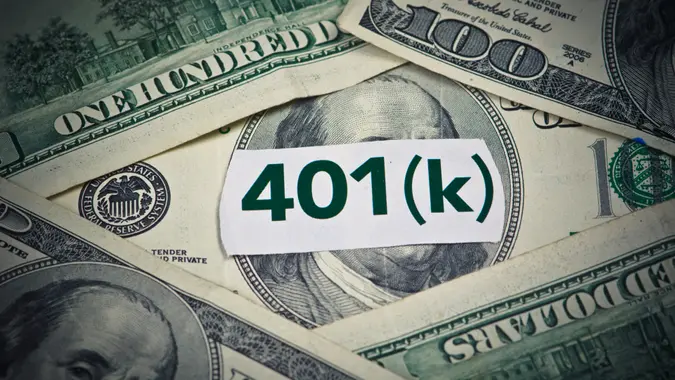Can the IRS Take Your 401(k)? What You Need To Know

Commitment to Our Readers
GOBankingRates' editorial team is committed to bringing you unbiased reviews and information. We use data-driven methodologies to evaluate financial products and services - our reviews and ratings are not influenced by advertisers. You can read more about our editorial guidelines and our products and services review methodology.

20 Years
Helping You Live Richer

Reviewed
by Experts

Trusted by
Millions of Readers
The IRS can seize funds from your 401(k) plan if you owe back taxes, but it must follow a process first. You’ll receive multiple notices, including a Final Notice of Intent to Levy. From that point, you have 30 days to respond and work out a resolution. If you don’t take action within that window, the IRS can move forward and levy the portion of your 401(k) you’re eligible to access.
The IRS Has Unique Power Over Retirement Funds
The IRS is one of the few government agencies that can legally seize money from retirement accounts, including your 401(k). If you fall behind on taxes and don’t resolve the issue, the IRS can place a levy and take funds you’re eligible to access. Other creditors, such as credit card companies or medical bill collectors, generally can’t touch your 401(k), which is why staying current with taxes is especially important.
When the IRS Can Seize Your 401(k)
Ignoring the IRS is never a smart move — failing to respond could put your retirement savings at risk. The agency must follow specific steps before it can touch your 401(k). Here’s when the IRS can step in and seize your account:
- Unpaid federal debt. Do you have unpaid taxes? If you have federal debt that you haven’t paid, the IRS can seize your 401(k).
- Ignored collection attempts. Have you failed to respond to the notices that the IRS has sent? If you have failed to respond, that puts the IRS one more step closer to placing a levy on your 401(k).
- Received a Final Notice of Intent to Levy. Have you received the Final Notice from the IRS? This is the last notice sent by the IRS.
- Fail to appeal. If you fail to appeal, then the IRS can seize your 401(k).
Tip: IRS Levies Only Apply to Eligible Funds
The IRS can’t touch money in your 401(k) unless you’re eligible to take distributions. In other words, if you can’t legally withdraw the funds yet, the IRS can’t levy them either.
Steps the IRS Takes Before Seizing Retirement Funds
The IRS can’t simply reach into your 401(k) overnight. By law, it must follow a series of steps before seizing retirement funds, giving you multiple chances to respond and resolve the debt. Here’s the process the IRS follows before a levy takes place:
- Step 1. Tax debt appears on IRS records
- Step 2. IRS sends multiple notices and bills
- Step 3. Final Notice of Intent to Levy
- Step 4. You have 30 days to appeal
- Step 5. You fail to appeal
- Step 6. IRS levies the 401(k)
What Part of Your 401(k) Can Be Taken by the IRS?
The IRS can only levy the portion of your 401(k) that you’re legally allowed to access. If you’re over 59½, that typically means any available balance is fair game. If you’re younger, the IRS may only take funds you’re eligible to withdraw early, such as through a hardship withdrawal. Loans you’ve already taken from your 401(k) aren’t subject to seizure, since they’re considered money you owe back to your plan, not accessible funds.
For example, a 45-year-old with a $100,000 balance may only be eligible to take out $10,000 through a hardship withdrawal. In that case, the IRS could levy only the $10,000 — not the full account balance.
Can Creditors Go After Your 401(k) Savings?
Your 401(k) cannot typically be seized by creditors. Your 401(k) is protected under the Employee RYour 401(k) is protected under the Employee Retirement Income Security Act (ERISA), which means most creditors — including credit card companies, personal lenders, and other private collectors — cannot touch your retirement savings.
However, there are important exceptions to these protections:
- IRS tax levies
- Court-ordered payments related to divorce or child support
- Criminal restitution orders
It’s also critical to remember that these protections apply only while the money stays in your 401(k). Once you withdraw funds, the money loses ERISA protection and becomes fair game for creditors.
How to Protect Your 401(k) from the IRS
While you can’t stop the IRS from collecting legitimate tax debt, you can take steps to reduce the risk of losing your retirement savings. The key is being proactive — ignoring notices or missing deadlines only makes it easier for the IRS to levy your 401(k). Here are a few practical ways to protect your account:
- Stay current on taxes and respond to IRS notices
- Set up a payment plan if you can’t pay in full
- Consider an Offer in Compromise (settle for less than owed)
- Don’t take early withdrawals if avoidable — they make funds accessible to seizure
What to Do If You Get an IRS Levy Notice
If you get an IRS levy notice, it’s in your best interest to act quickly. Here’s how you can tackle the problem and protect your savings.
- Contact the IRS right away. Don’t ignore IRS notices. Reaching out quickly shows good faith and gives you the best chance to work out a solution before a levy is enforced.
- Request a collection due process hearing (if eligible). You can only request this hearing if you’ve received a Final Notice of Intent to Levy or a Notice of Federal Tax Lien. To qualify, you must file Form 12153 within 30 days.
- Get professional help. If you’re unsure how to respond, a tax professional or attorney can explain your options and guide you through the process.
- Act before the levy takes effect. Once the IRS enforces a levy, your 401(k) funds may be frozen. Taking action early is the best way to protect your money.
Will the IRS Really Take Your 401(k)?
The IRS can dip into your 401(k), but only in certain situations. They’re limited to the money you’re actually eligible to withdraw, and they can’t move forward without sending you several notices first. Once you get a Final Notice of Intent to Levy, you have 30 days to respond. Acting during that window is critical — it could mean stopping the levy entirely or at least protecting more of your retirement savings.
FAQ
- Can the IRS take my 401(k) without warning?
- No. The IRS must send several notices first, including a Final Notice of Intent to Levy, which gives you time to respond or appeal.
- Can the IRS take my 401(k) if I haven’t reached retirement age?
- Yes, but only if you’re eligible to withdraw money early. The IRS can levy the portion you’re allowed to access, such as through hardship withdrawals.
- Will my employer be notified?
- Yes. Since your employer or plan administrator manages the 401(k), they’ll be notified if a levy is issued.
- Can I stop a levy once it starts?
- In some cases. You may be able to stop or release a levy by paying the debt, setting up an installment plan, proving financial hardship, or negotiating an Offer in Compromise.
- What happens if I’m already taking withdrawals?
- The IRS can redirect those withdrawals and apply them toward your tax debt until it’s resolved.
 Written by
Written by  Edited by
Edited by 

























